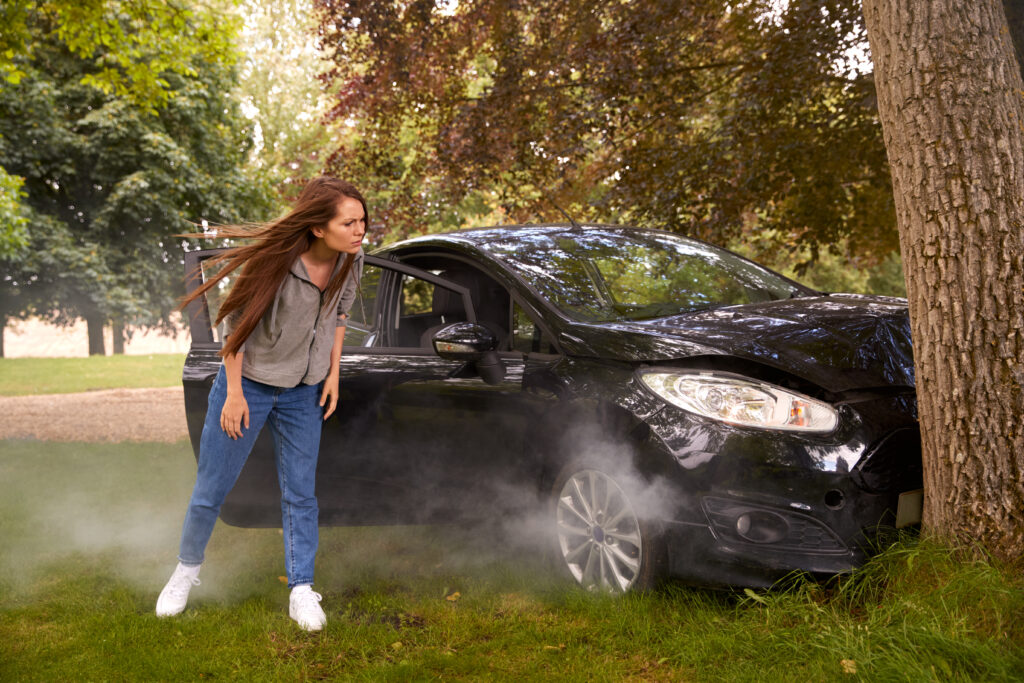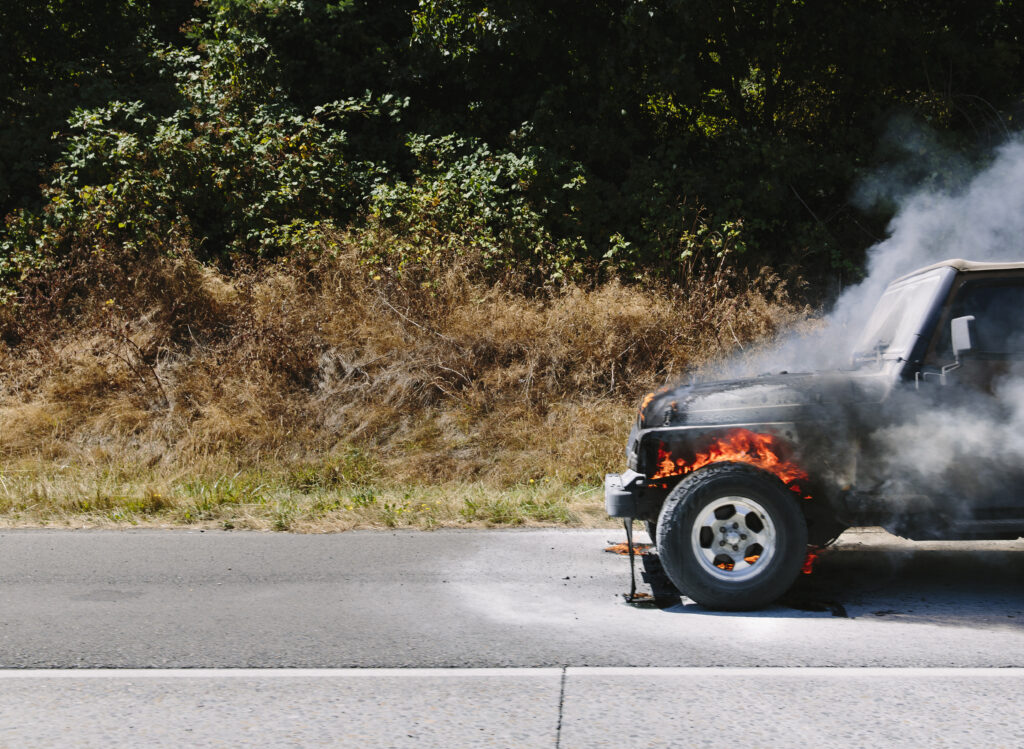Every driver knows the fear of seeing flames coming from their car, especially while driving. Car fires can be a terrifying experience for anyone on the road, and burning vehicles pose significant dangers due to the quick onset of extreme heat, toxic gases, and the risk of explosive incidents. Therefore, it is important to know how to handle them in order to stay safe and prevent further damage.
This blog will guide you through the critical steps to take if your car catches fire, providing practical advice and insight for drivers, car owners, and safety enthusiasts. Stay with us to learn how to recognize the signs of a car fire, what immediate actions to take, and how to stay safe during such emergencies.
Common Causes of Car Fires
As reported by the National Fire Protection Association (NFPA), vehicle fires accounted for 16 percent of fire-related fatalities in 2022, the latest year for which data is available. With the average age of vehicles on the road steadily increasing, the NFPA highlights that the risk of vehicle fires due to mechanical and electrical malfunctions also rises.
Car fires can stem from several sources, many of which are preventable. Faulty wiring, overheating engines, and leaking fuel lines are among the most common culprits.
Electrical issues often arise from poorly maintained batteries or incorrectly installed aftermarket accessories. Overheating may result from low coolant levels or broken fan belts, while fuel leaks could originate from damaged fuel lines or loose connections.
Moreover, human error also plays a significant role in car fires. Leaving a lit cigarette inside a vehicle or improperly storing flammable materials can easily ignite a fire. Always store items like gasoline containers, propane tanks, and aerosol cans safely outside the trunk of your car to minimize risk.
Signs of a Car Fire
Unusual Smells
One of the first indicators of a car fire is an unusual smell. Burning rubber, plastic, or gasoline odors should never be ignored. These scents often signal that something is wrong under the hood or within the vehicle’s interior.

Smoke Signals
Smoke is a clear sign that your car is in trouble. If your vehicle’s hood is smoking, pull over immediately. Smoke can vary in color, from white to gray to black, indicating different types of fires or malfunctions. White smoke may suggest a coolant leak, while black smoke could mean an oil or fuel fire.
Visible Flames
Visible flames are a more obvious sign that your car is on fire. Flames can appear anywhere in or around the vehicle, and if you spot them, you need to act swiftly to ensure your safety and the safety of others around you.
Dealing With a Car Fire
In 2021, around 174,000 highway vehicle fires were reported in the United States, representing a slight uptick from the 173,000 incidents recorded the year prior. Vehicle fires are common enough to warrant serious attention from drivers, making it crucial to know how to respond if your car catches fire. Below, we will outline the essential steps to take in such an emergency.
1. Pull Over and Park Safely
The moment you realize your car is on fire, pull over to the side of the road as quickly and safely as possible. If you are on a highway, try to make it to an exit or rest area where there are fewer cars passing by.
Once stopped, put your hazard lights on immediately to alert other drivers and passengers of the situation.
2. Turn Off the Engine
Turning off the engine is crucial to stopping the flow of fuel, which could feed the fire. Remove the key from the ignition and keep it in a safe place with you where you can easily grab it later.
3. Evacuate Everyone From the Vehicle
As soon as you come to a stop, get out of the car with all the passengers in tow. Exit through the driver’s side door if possible, but do not waste any time trying to open a jammed door. Instead, break a window using an emergency escape tool or any hard object you can find.
Make sure everyone is at a safe distance from the burning car and move away quickly. If there are any bystanders, warn them to stay back as well.
4. Call for Help
As soon as you are in a safe location, call emergency services. Whether it’s 911 or local fire department numbers, make sure to report the incident and your location accurately. Stay on the line until you have confirmed that emergency responders are on their way.
While your instinct may urge you to extinguish or fight the fire yourself, using the wrong method could escalate the situation rather than help it. Consider the following points:
- Opening the car hood allows more air to reach the flames, which can intensify the fire.
- Avoid using water on the flames, as it might spread burning fuel to other areas, creating additional hazards.
- If you must attempt to extinguish the fire without the appropriate fire extinguisher, using earth or sand can effectively smother the flames.
5. Stay Clear Until the Fire Is Completely Out
Even if the flames have been extinguished, it is crucial to stay clear of the burning vehicle until authorities confirm that it is safe. Car fires can reignite unexpectedly, and there may still be toxic gases in the air or hazardous materials on the ground. Avoid going back to retrieve any personal belongings until you are given the all-clear.

Safety Measures to Avoid Car Fires
Taking proactive measures is essential in preventing car fires and ensuring your safety on the road. Regular vehicle maintenance plays a crucial role in identifying potential fire hazards before they become serious issues. Here are some key safety measures to consider:
Routine Inspections
Conduct routine vehicle inspections, paying special attention to the electrical system, fuel lines, and engine components. Look for any signs of wear or damage, such as frayed wires, leaks, or rusted parts, and address them promptly.
Maintain Your Battery
Ensure your battery is in good condition and securely mounted. Clean the battery terminals regularly to prevent corrosion, and check for any signs of leaking electrolytes, which can pose a fire risk.
Mindful Driving Habits
Avoid aggressive driving or overloading your vehicle, as this can lead to overheating. Additionally, be cautious when using aftermarket accessories, ensuring they are professionally installed to prevent electrical issues.
Safe Storage of Flammable Items
Never leave flammable items inside your vehicle. If you must carry such materials, store them in sealed, fire-resistant containers outside the passenger area.
Always Have an Emergency Kit
An emergency car kit is an essential component of responsible vehicle ownership. It equips drivers with the necessary tools and supplies to handle unexpected situations such as breakdowns, accidents, or fires. In the event of a car fire, having a fire blanket and a fire extinguisher in your emergency kit can be lifesaving.
Why a Fire Blanket?
A fire blanket can quickly smother small fires before they escalate, providing a crucial first line of defense. It is especially useful for covering the flames and preventing oxygen from fueling the fire. In the case of a burning engine or passenger compartment, a fire blanket can also be used to shield yourself while evacuating passengers or protecting them from flames during an emergency escape.
Why a Fire Extinguisher?
Carrying a fire extinguisher specifically designed for automotive use is equally vital. These extinguishers can tackle various types of motor vehicle fires, including those caused by flammable liquids or electrical malfunctions typical in vehicles.
Only use these items if it is safe to do so and if you have been trained in their proper use. Otherwise, focus on getting yourself and others safely out of harm’s way while waiting for the arrival of emergency services.
Post-Fire Steps
Assessing the Damage
After the fire has been extinguished, do not re-enter the vehicle until professionals have deemed it safe. Assess the damage from a distance and take pictures if possible. These will be helpful for insurance purposes.
Contacting Your Insurance Company
Notify your insurance company about the accident or incident as soon as possible. Provide them with all necessary details and documentation, including photos and a police report if available. Your insurer will guide you through the next steps for claims and repairs.
Vehicle Recovery and Repairs
Depending on the extent of the damage, your car might either be salvageable or deemed a total loss. Work with your insurance company and a trusted mechanic to determine the best course of action. If repairs are feasible, ensure they are done by certified professionals to prevent future issues.

FAQs
Q. How do you prevent a vehicle from catching fire?
To prevent a vehicle fire, it is essential to properly maintain your car and look for warning signs such as unusual smells or smoke. Regularly check and replace worn-out parts, avoid overloading the vehicle with too many passengers or cargo, and be cautious when handling flammable materials.
It is also crucial to have an emergency car kit with a fire blanket, emergency blanket, and extinguisher on hand in case of any unexpected incidents. Always follow proper procedures while fueling or performing maintenance on the car to reduce the risk of fires. So, these are some steps that can help prevent a vehicle from catching on fire.
Q. What do you do if your vehicle hood is smoking?
If you see smoke coming from your vehicle’s hood, pull over safely and follow the steps outlined above. Do not attempt to open the hood or put out the fire yourself unless you have proper training and equipment. Evacuate the car immediately, call emergency services, and keep a safe distance until help arrives.
Conclusion
While car fires can be frightening and unpredictable, knowing what to do in these situations can save lives. Stay calm, follow the steps outlined above, and prioritize your safety and the safety of others.
Regular maintenance and proper preparation can also help prevent car fires from happening in the first place. So always make sure to take necessary precautions and keep yourself informed about potential warning signs to ensure a smooth driving experience for you and your passengers.
Remember to check your vehicle regularly, have an emergency kit on hand, and know how to respond in case of a fire. By following these guidelines, you can minimize the risk of a car fire occurring while on the road.

0 comments